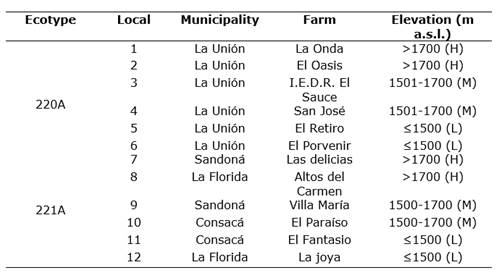INTRODUCTION
Colombian coffee transitioned from being unique due to its overall characteristics to have quality attributes determined by agroecological conditions associated with the coffee variety, benefit process, and growing region. Additionally, the coffee origin is important for positioning on national and international markets (Raynolds, 2009; Sepúlveda et al., 2013). The factors that affect cup quality are highly variable and represent a bottleneck for creating protocols to obtain quality products. Accordingly, Orozco et al. (2011) determined an unclear association between variety, elevation, soil, and cup quality. The characteristics that define cup quality are determined by a series of physical and chemical variables, such as color, characteristic diameter, equatorial and polar firmness, fresh and dry weight, moisture content, fresh, dry weight ratio, titratable acidity, soluble solids, and pH of the pulp, as well as organoleptic traits such as aromatic intensity, bitterness, body, aroma, and overall standard (Moreno, 2007).
Coffee grain yield, chemical composition, and physical characteristics can be modified or limited by factors such as temperature (i.e., as a result of altitudinal effects) that prolong maturity of the coffee berry, thus favoring grain-filling and cup quality. Furthermore, other relevant factors include the origin of the soil and fertility, atmospheric conditions, harvest time and distribution, moisture content of the coffee berry, and collection methods and quality (Montilla et al., 2008; Suárez et al., 2015).
The selection of the components of the Castillo variety involved an assessment of the physical and organoleptic beverage’s attributes concerning the genotype. A descriptive analysis of its components was used to identifying the genotypic groups that contribute to its sensory characteristics (Alvarado et al., 2009).
The maturation process involves physico-chemical changes in the coffee berry. Marín et al. (2003) determined that the physical changes most associated with fruit maturation were removal force and equatorial and polar firmness since these variables decreased as the berries matured. The best-scored cup was obtained from semi-ripe, ripe, and over-ripe berries, while unripe green and dry berries received low quality scores. The best coffee cup quality is derived from adequately processed ripe berries, reflected by the flavor and aroma (Puerta-Quintero, 2000a).
A comparison between grains developed under shade and sun exposure indicated that the former display greater development of the periplasm, which contributes to grain size and reduced sucrose and sugar contents that delay fruit maturation (Geromel et al., 2008).
Quality is also associated with specialty; therefore, the coffee must meet characteristics associated with a particular flavor and be originated from outstanding ecological niches, where crops are subjected to strict management standards. For these reasons, the consumer is willing to pay a higher price (Castro et al., 2004). According to Farfán (2007), specialty Colombian specialty are characterized by their excellent quality, consistency in their physical and sensory properties, benefit, and preparation.
Ramos and Criollo (2017) state that cup quality is a multifactorial variable. These authors determined that elevation does not directly affect quality, although it is inversely related to the presence of the coffee berry borer, low phosphorous content, and reduced fermentation (16-17 h) and drying (20-25 h sunlight) times, which were associated with higher quality scores.
In the international market, coffee quality is defined by physical attributes such as size, shape, color, and uniformity, as well as organoleptic traits such as acidity, body, aroma, flavor, roasting, and visual features (i.e., color and clarity of the infusion) (Estrella and Chaves, 2008; Céspedes, 2012). These attributes and characteristics are unique to each variety and, along with benefit, are responsible for the final quality of the coffee beverage (Alvarado and Puerta, 2002). The Castillo variety displays grain and quality traits similar to or better than other crop varieties traditionally grown. Furthermore, the quality characteristics of Caturra, the Timor hybrid, and Castillo are highly homogenous. The beverages show body, slight bitterness, pronounced aroma, and acidity for medium degrees of roasting. Coffee processing under similar and optimal conditions during benefit, roasting, and beverage preparation do not show significant differences in cup quality (Alvarado et al., 2009; Alvarado et al., 2005).
The contrasting results among different authors has not allowed clearly establishing the environmental requirements and optimal pre and post-harvest managements to achieve long-term high-quality standards. Therefore, coffee-growers who produce high-quality coffee are currently hesitant about the factors that contribute to this attribute and, thus, struggle when attempting to maintain the high-quality levels required by specialty markets.
This research aimed to characterize the edaphoclimatic offer for Castillo coffee variety in ecotypes 220A and 221A of the Department of Nariño and to establish the association between environmental offer and cup quality.
MATERIALS AND METHODS
This study was conducted in farms growing coffee trees of the Castillo variety in ecotypes 220A and 221A of the Department of Nariño. Ecotype 220A is located in the Patía river basin and the sub-basins of Juanambú and Mayo rivers between 1°21’ and 1°42’N at 1300 to 1800 m.a.s.l., with an annual precipitation ranging from 1700 to 1900mm. This zone is characterized by shallow soils of volcanic origin (i.e., from Doña Juana volcano), with low organic matter content, medium natural fertility, and susceptibility to erosion. The coffee crops are characterized by scattered shade trees. Moreover, ecotype 221A is found in the Guitara river basin located between 1°05’ and 1°36’N at 1400 to 2100 m.a.s.l., with annual precipitation ranging from 1400 to 1700mm. It is characterized by shallow soils derived from volcanic ash, with low moisture retention capacity and susceptibility to erosion (Gómez et al., 1991). Traditional crop management is related to family economy.
In this study, 82 coffee growers with young coffee crops (3-5 years) of the Castillo variety were selected, who were located at three altitudinal strata: high (H), medium (M), and low (L). Among these coffee growers, 12 were chosen as representatives of the two ecotypes (six per ecotype as quota) using non-probabilistic quota sampling (Otzen and Manterola, 2017). In each ecotype, two coffee farms were selected per altitudinal strata (Table 1).
Each sampling unit consisted of crops with different agronomic practices and conventional (chemical) fertilization. Furthermore, at each unit, passport information was recorded and the location was georeferenced using a Garmin global positioning system device.
The edaphoclimatic variables analyzed were maximum and minimum temperatures, relative humidity, photosynthetically active radiation, and precipitation. These data were obtained from records for a single year from meteorological stations (Spectrum Technologies, Inc. Model: 2900ET Weather Station), located at the experimental farms objective of the SGR project entitled “Evaluation of the effect of shade by different tree species on the agronomic behavior and quality of coffee, Consacá, Nariño, Occidente” (Investigación evaluación del efecto de sombra de diferentes especies arbóreas en el comportamiento agronómico y calidad de café, Consacá, Nariño, Occidente).
Soil trait data related to pH, cation exchange capacity (CEC), organic matter (OM), nitrogen (N), phosphorus (P), potassium (K), calcium (Ca), boron (B), iron (Fe), zinc (Zn), copper (Cu), manganese (Mn), magnesium (Mg), carbon (C) and sulfur (S) were obtained from the analyses carried out by specialized laboratories of the Universidad de Nariño, which determined
The traits for cup quality were determined based on physical and sensory analyses. They included: fragrance/aroma (Fr/Ar), flavor (Fl), residual flavor (Fr), acidity (Ac), body (Bd), uniformity (Un), balance (Bl), pH, score assigned by the taster (St), and total score (TS). The Specialty Coffee Association of America-SCAA (2015) established a classification according to the score obtained: <80 below the score for a specialty coffee, 80 - 84.99 very good, 85- 89.99 excellent, and 90 -100 exceptional. The analyses were conducted according to the norms and procedures of Juancafé private laboratory in the city of Pasto, Nariño, which follows the standard protocols of the Specialty Coffee Asociation (SCAA) and the norms of the Federación Nacional de Cafeteros de Colombia, and it has Q grader tasters certified by the Coffee Quality Institute.
During the main harvest, between April and June, 10 kilograms of coffee cherry were manually collected at each farm and processed through traditional methods. The beans were sun dried at each farm. When the grains reached 10-12% humidity, three random samples of 500 g of dry parchment coffee- DPC were taken to Juancafé private laboratory for their physical and sensory analyses (i.e., tasting process).
All of the variables were organized and categorized for the multivariate principal component analysis (PCA), which provides a summarized multivariate description of study conditions, individuals, or sites and allows comprehending the structure of the associations across the variables (Ávila et al., 2015). Next, a clustering analysis was conducted based on criterion Ward (1963) , which is an appropriate statistical method to group variables so that the inertia within groups is minimum and between groups is maximum. The multivariate and cluster analyses were done with the SPAD- 6.3 software.
RESULTS AND DISCUSSION
The cup quality scores varied between 76.50 and 85.50 (Table 2). Puerta-Quintero et al. (2016) indicate that lower temperatures and elevations above 1600m promote better conditions for healthy coffee production. Furthermore, low temperatures allow for natural and controlled fermentation; however, this is not enough to determine cup quality. In contrast, this study found that the highest cup quality was obtained at low elevation (≤1500 m.a.s.l.) in El Retiro farm in ecotype 220A. In this regard, Lara and Vaast (2007) state that elevation can significantly influence the biochemical composition and physical and sensory quality of the coffee cup. Ramos and Criollo (2017) found a low correlation (-0.42) between elevation and cup quality. Similarly, Cruz et al. (2017) did not find differences in cup quality in response to the altitudinal range (1300 and 1800 m.a.s.l.). Therefore, coffee cup quality is not determined by one or a few variables but is rather the result of the entire production and benefits processes (Aristizabal and Duque, 2006), as confirmed by Orozco et al. (2011).
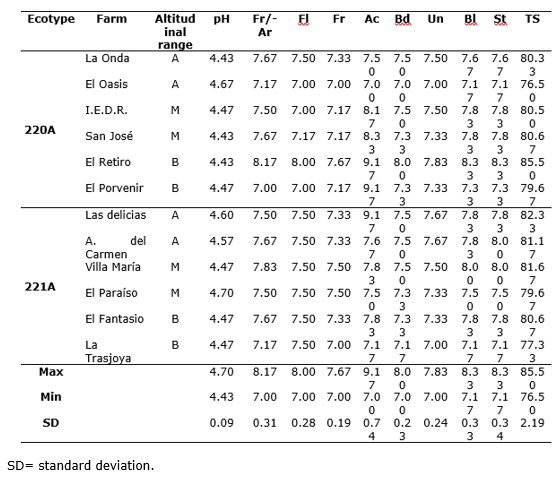
Table 2. Behavior of sensory variables: fragrance/aroma (Fr/Ar), flavor (Fl), residual flavor (Fr), acidity (Ac), body (Bd), uniformity (Un), balance (Bl), pH, score assigned by the taster (St), and total score (TS), assessed for determining coffee cup quality in Nariño.
The PCA of the soil and cup quality variables (Table 3) showed that the first three components explain 77.24% of the total data variability. The first component, accounting for 35.70% of the variability, comprised variables P, Ca, Zn, and B with correlation factors (CF) between -0.81 and -0.89. The second component, contributing to 27.19% of the variance, was mainly composed of variables N and C, with CF of 0.84 and 0.82, respectively. The highest CF for component 3 was obtained for the variable S (sulfur content), indicated by a value of -0.81.
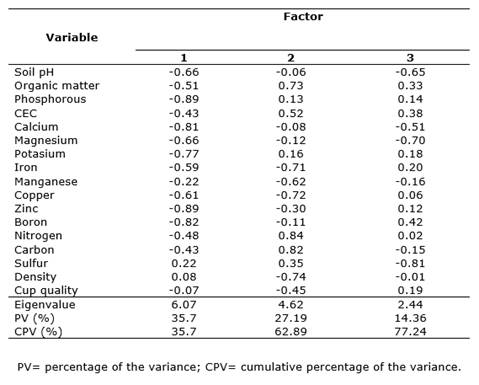
Table 3. Factor-variable correlations and contribution to variability of the first three principal components associated with soil variables and cup quality.
The highest CF for cup quality was observed in component 2 with a negative direction, and it was shared by iron and soil density, which contributed most to this component. This negative direction and high contribution of iron (Table 3) confirm the findings reported in Mexico by Rosas et al. (2008), who demonstrated a positive influence of this element on the fragrance of the infusion, being able to identify subgroups, including nuts, chocolates, florals, caramels, fruits, and phenolics. Furthermore, they reported a negative contribution of Cu on the intensity of the acidity.
The classification analysis identified three groups. The first group comprised estates 1, 4, 2, 3 ,12, and 10; the second group was composed of estates 5, 6, 8, 9, and 11; and group 3 comprised estate 7, which was far away from the others (Figure 1).
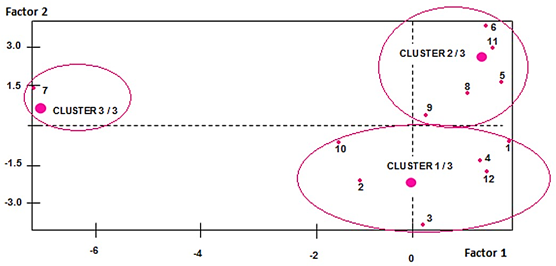
Figure 1. Distribution of the first two principal components for the estates analyzed based on the soil factor and the three groups identified in the classification analysis.
The soils of the first group of estates showed significant differences (p<0.05) in Mn content (30mg/kg), higher density (1.07g/cc), higher Cu content (3.72mg/kg), and higher Fe content (138.67mg/kg) than the overall means of the study population (16.97mg Mn/kg, density of 1.06mg/kg, 2.66mg Cu/kg, and 109.51mg Fe/kg). Additionally, these soils showed organic matter (3.44%), nitrogen (0.13%), and carbon (1.87cmol/kg) contents below the overall means (4.63%, 0.19%, and 2.81cmol/kg, in the same order).
Group 2 was characterized by higher nitrogen (0.23%) and carbon (3.61cmol/kg) contents than the overall means (0.19% and 2.81cmol/Kg, in the same order). Furthermore, this group showed lower density values (0.92g/cc) and Zn (0.65mg/Kg), Mn (2.29mg/Kg), Cu (0.91 mg/Kg), and Fe (58.02mg/Kg) contents in contrast to the overall means (1.00 g/cc, 2.56mg Zn/Kg, 16.97mg Mn/Kg, 2.66mg Cu/Kg, and 109.51mg Fe/Kg.
Group 3 comprises estate 7 and showed values greater than the overall mean for most variables analyzed, except for Mn (12.2mg/Kg), S (2.4mg/Kg), density (0.94g/Kg), and cup quality score (79.67%); this last variable was very similar to the overall mean of the population analyzed (80.5%). Suárez et al. (2015) indicated a high association between the sensory attributes of cup quality and the chemical characteristics of the soil; furthermore, the authors determined that acid soils with high Fe and Al contents lead to intermediate and high-quality coffee cups. The same study reported that low cup quality was associated with moderately acid soils with high Cu, Zn, S contents, and low Ca and Mg contents. Alternatively, they reported a negative relationship between cup acidity and Ca content and a positive correlation between fragrance/aroma and soil K, Na, and Al contents.
The first two PC groups, which account for 91.6% of the population, arrange the estates close to the origin. This reflects the few differences in the edaphic characteristics of these soils compared with the overall mean. The remaining 8.33% of the population comprised estate 7, or group 3, which was distant from the origin and showed clear differences in its edaphic traits compared to the other estates assessed.
However, despite the differences between groups, cup quality was similar across groups (80.89, 80.2, and 79.6 for groups 1, 2 and 3) and the overall mean (80.5%). Therefore, this study could not establish the effect of certain soil variables on the physical and organoleptic quality of the coffee beverage. Accordingly, cup quality should be considered a multifactorial variable that depends on the genotype, environment, and the interaction between these two components (Suárez et al., 2015; Ramos and Criollo, 2017).
The PCA of the climatic variables allowed explaining 84.64% of the total variance in three large components. The first component accounted for 51.5% of the variability, the second component explained 17.62%, and the third contributed to 15.44% of the variance (Table 4). Precipitation, photosynthetically active radiation (PAR), and solar radiation were most variable across the estates analyzed.
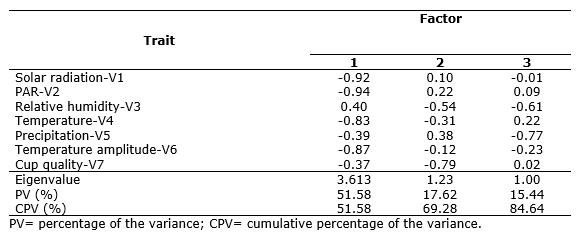
Table 4 Factor-trait correlations and contribution to variability of the first three principal components associated with climatic variables and coffee cup quality.
The first component mainly included: solar radiation, PAR, temperature, and temperature amplitude with CF between 0.83 and 0.94. Similarly, component 2 comprised the variables relative humidity (-0.54) and cup quality score (-0.79). Lastly, relative humidity and precipitation were determinant variables of component 3, with CF of -0.61 and -0.77, respectively.
The classification analyses allowed identifying three groups. The first group encompassed estates 1, 2, 11 and 12 that represent 33.3% of the total estates. The first two coffee farm estates are located in the municipality of La Unión at elevations between 1501 and 1700m, while the last two are located in the municipality of La Florida at ≤1500m and >1700 m.a.s.l., respectively. The second group included estates 3 and 4, which account for 16.6% of the estates and are located in La Unión between 1501 and 1700 m.a.s.l. The third group comprised estates 5, 6, 9, 10, 7, and 8, representing 50% of the estates (Figure 2).
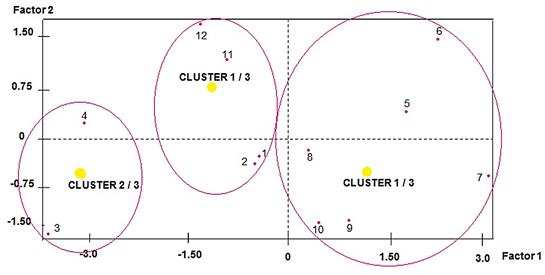
Figure 2 Distribution of the estates analyzed in the first two principal components based on the environmental factors and the three groups identified through the classification analysis.
The coffee farm estates of the first group are characterized by greater precipitation (721.1mm) compared with the overall mean (572.88mm). Furthermore, other variables that showed higher values than the overall mean were thermal amplitude (5.26°C) and PAR (412.98nm). The cup quality score of the coffee produced in these lands was 79.92%, while the overall mean was 80.5%.
Group 2 (Figure 2) comprised farms that received higher solar radiation (256.44W/m2), greater PAR (509.51nm), and showed greater diurnal and nocturnal temperature amplitude (5.95°C) in comparison to the overall means (202.77W/m2, 401.06 nm, and 4.86°C, in the same order). The cup quality score of these farms was 82.85.
The farms in group 3 were characterized by higher relative humidity (73.41%) than the overall mean (72.73%). Additionally, they showed lower temperature amplitude (4.23°C), precipitation (457.13mm), PAR (356.96nm), solar radiation (184.75 W/m2), and environmental temperature (18.94°C) compared with the overall means (4.86°C, 572.88mm, 401.06nm, 202.77W/m2, and 19.64°C, respectively). Coffee cup quality (80.2) for this group was very similar to the overall mean (80.5).
Several studies found that the highest scores for the sensory attributes of the cup are obtained from shade-grown coffee at higher elevations. This demonstrates the need to adequately manage tree cover along with elevation (Suárez et al., 2015). The effects of shade trees on coffee production are difficult to characterize since studies often omit important data or do not quantify them; for instance, intensity and quality of the radiation that reaches the tree canopy, daily and seasonal fluctuations in temperature and relative humidity, nutrition, and overlooked crop management conditions (DaMatta and Ramalho, 2006; DaMatta and Rodríguez, 2007). In this study, no tendency was observed regarding quality in response to the environments in ecotypes 220A and 221A.
Coffee benefit comprises all the processes aimed to transform the coffee berry into dry parchment coffee without affecting its organoleptic, sanitary, and physical characteristics (Gómez, 2010). The analysis of variables associated with this process showed that 41.6% of the farms mix coffee from different harvest days before the fermentation process, and 50% select the coffee after washing. Furthermore, 75% use a motorized coffee pulper, 16.6% use a mucilaginator, and the remaining farms use a manual pulper. After drying, only 16.6% of coffee producers obtain humidity between 10 and 12%, while 83.3% package the coffee grain with more than 12% humidity. Low humidity contents provide the coffee grain with greater stability of its organoleptic characteristics; thus, better conserving its quality (Puerta-Quintero, 2006).
Regarding the pH of the fermenting mass, 75% of producers begin with a pH between 5.0 and 6.5. This data agrees with Córdoba-Castro and Guerrero-Fajardo (2016) , who found an initial fermenting pH between 5.5 and 5.6 for Castillo variety. Puerta-Quintero (2013) reported an initial pH of 5.6 and indicates that these values depend on the maturity of the grain, the time between collection and pulping, and fruit manipulation. Moreover, 8.3% of the farms begin the process with a pH>6.5, while 16.6% do not ferment the coffee grain. Additionally, 25% of the producers terminate the process when the pH is between 3.0 and 3.5, while 58.3% end it at a pH>3.5. According to Jackels and Jackels (2005) , a final pH of 4.6 may be optimal to terminate the fermentation process without risking over-ferment of the grain.
During fermentation, the pH decreases due to the increased acidity of the mass. Generally, pH values between 3.7 and 4.1 for the fermented mucilage are adequate and safe to interrupt the fermentation process (Puerta-Quintero, 2012). Only 8.3% of the producers achieved ‘excellent’ cup quality scores, 41.6% produced coffee with a ‘very good’ qualification, and 50% did not achieve a specialty coffee qualification due to scores below 80 points.
CONCLUSIONS
Coffee cup quality scores did not show an association with elevation. The highest score was achieved for coffee grown at ≤1500 m.a.s.l. Low levels of association were found between the soil variables and cup quality; furthermore, Fe and Cu contents showed the highest association levels among the variables assessed.
The farms in La Unión showed the highest radiation, PAR, and thermal amplitude and conformed a group with the highest cup qualities. The characteristics associated with higher cup quality were found La Unión and Consacá in production units located at elevations ≤1500 m.a.s.l.













